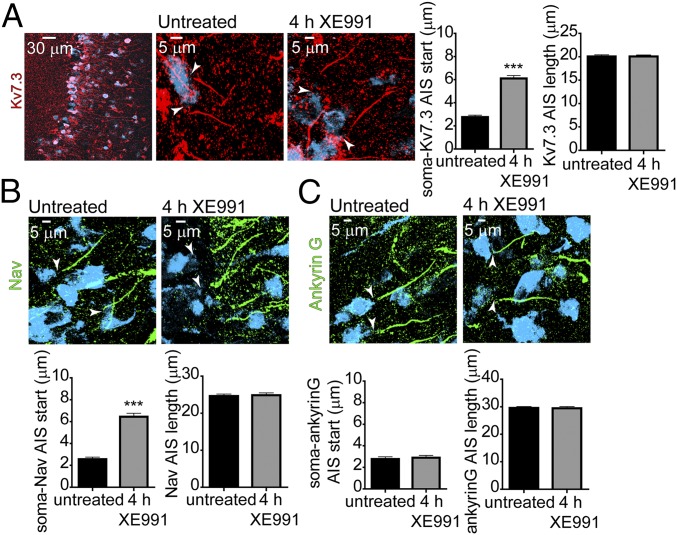Fig. 6.
M-channel inhibition in CA1 hippocampal neurons triggers a fast distal shift of AIS Nav and Kv7.3 channels but not ankyrin G. (A, Left) Kv7.3 and NeuN immunolabeling of CA1 pyramidal neurons from a hippocampal slice at low magnification. (Center) Kv7.3 and NeuN immunolabeling of untreated CA1 pyramidal neurons and neurons chronically exposed to XE991 (4 h) at higher magnification. (Right) The Kv7.3 segment in the AIS significantly shifted away from the soma following XE991 treatment [two-tailed unpaired t test, untreated (n = 201) vs. XE991 (n = 193): ***P < 000.1, t = 11.27, df = 392], whereas its length did not change. (B, Upper) Nav and NeuN immunolabeling of untreated CA1 hippocampal neurons and CA1 pyramidal neurons chronically exposed to XE991 (4 h). (Lower) The Nav segment in the AIS significantly shifted away from the soma following XE991 treatment [two-tailed unpaired t test, untreated (n = 156) vs. XE991 (n = 129): ***P < 000.1, t = 10.83 df = 283], whereas its length did not change. (C, Upper) Ankyrin G and NeuN immunolabeling of untreated CA1 pyramidal neurons and CA1 pyramidal neurons chronically exposed to XE991 (4 h). (Lower) The AIS ankyrin G segment did not redistribute away from the soma after 4 h of XE991 exposure [two-tailed unpaired t test: not significantly different in untreated (n = 159) vs. XE991-treated (n = 143) neurons, P = 0.6852, t = 0.4058 df = 300], and its length remained the same.

